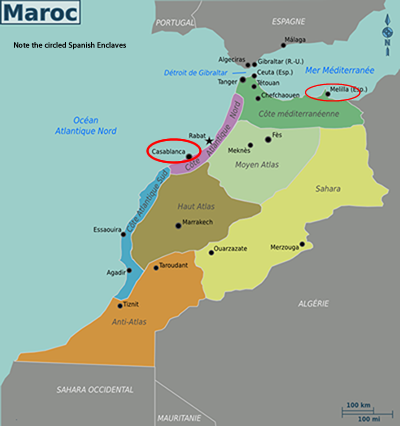Casablanca Morocco April 16, 2017
Visiting Casablanca in Morocco on Easter Sunday was interesting. Although basically a Muslim Country, there is a cathedral in Casablanca which was celebrating Easter. Morocco is a very tolerant country. Especially since 1999 when King Hassam II was succeeded by his son, King Mohammed VI who was educated in the U.S. He has an earned PhD from Princeton and an honorary one from Duke and is slowly modernizing the country.
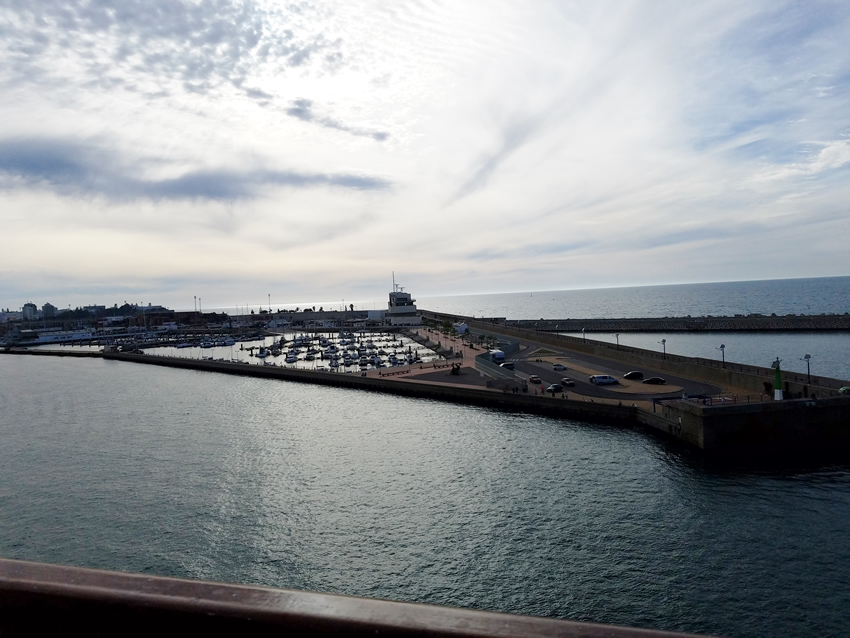
This was the view from the ship that greeted us early in the morning.
Although, Morocco is a constitutional monarchy, the King is the arbiter of all religious matters. In March 2000, more than 60 women's groups consisting of 40,000 women, organized demonstrations in Casablanca proposing reforms to the legal status of women in the country such as a ban on polygamy and the introduction of divorce law (divorce being a purely religious procedure at that time). Although the counter-demonstration attracted half a million participants, the movement for change which started in 2000 was influential on King Mohammed VI. In 2004 he enacted a new mudawana, or family law, meeting some of the demands of women's rights activists. Women do not have to wear the head scarf or other clothing that we associate with Islam, although we saw some older women who still dressed in burquas. An interesting disconnect for me was seeing a burka clad saleswoman selling a flimsy piece of lingerie to a woman with a headscarf.
Morocco was not immune to the Arab Spring. Thousands of people rallied in Rabat and other cities calling for political reform and a new constitution curbing the powers of the king. In response, the King proposed a new constitution which received a landslide victory in July 2011. Things are quite calm there now.
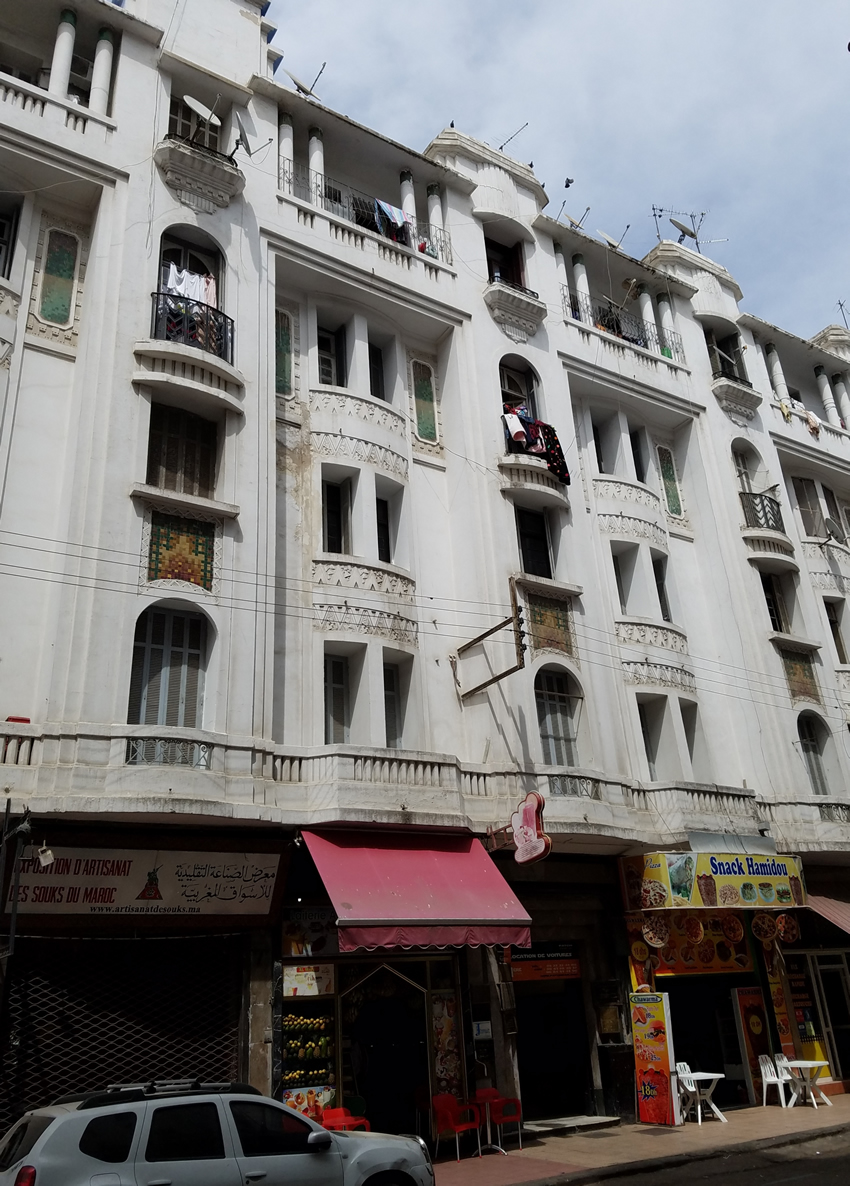
A typical building in the city.
The King is also very active in promoting development. Besides the “artificial” port in Casablanca (it was a small port that was artificially enlarged) where we moored, the port in Tangier is currently being artificially enlarged. As with many places in Asia and Africa, the Chinese have invested heavily. We saw a lot of shipping; one of our group counted 15 freighters there. Additionally, it is the home of the Moroccan Navy. They also have an army and air force, which seems to be a requirement today of all countries.
The promotion of tourism is another goal of the King. He travels extensively promoting Morocco and recently abolished visa requirements for the Chinese with a resulting 30% increase in Chinese tourists in just a year. (We encountered the result.) He is also good friends with the King of Jordan and shares the same aims of bringing their countries into the modern world without creating the backlash so often created by those who are part of the religious power struture when they lose power.
Casablanca itself is the largest city in the Maghreb (the region of western North Africa or Northwest Africa, west of Egypt, sometimes called the Barbary Coast). It is also one of the largest and most important cities in Africa, both economically and demographically. It is Morocco's chief port and one of the largest financial centers on the African continent, although the political capital is Rabat, an hour’s drive south.

Like Oman, Casablanca has a Corniche, or road and promenade along the ocean. However, this one is not completely free of buildings.
Morocco was settled by Berbers in the seventh century BC, later used as a port by the Phoenicians, an ancient seafaring civilization composed of independent city-states located along the Eastern Mediterranean coast stretching through what is now Syria, Lebanon, and northern Israel. Morooco was independent until seized in 1068 by the Almoravids (the same fundamentalist group that nixed the Golden Age of Spain). In the 14th Century the Merinids replaced the Almoravids, and they were ousted in 1465 by a popular revolt after which Morroco was again independent. Casablanca then became a safe harbor for pirates, which as you can imagine annoyed the Portuguese who bombarded it in 1468, and in 1515 built a military fortress on the ruins.
The Portuguese abandoned Casablanca in 1755 after a devastating earthquake. With the help of Spaniards the town was finally reconstructed by Sultan Mohammed ben Abdallah (1756–1790), an ally of George Washington. In the late 18th century, Spanish merchants and other European traders began to settle there. After a time the French outnumbered all the other Europeans and in 1907 occupied the town. Morocco gained independence from France on 2 March 1956.
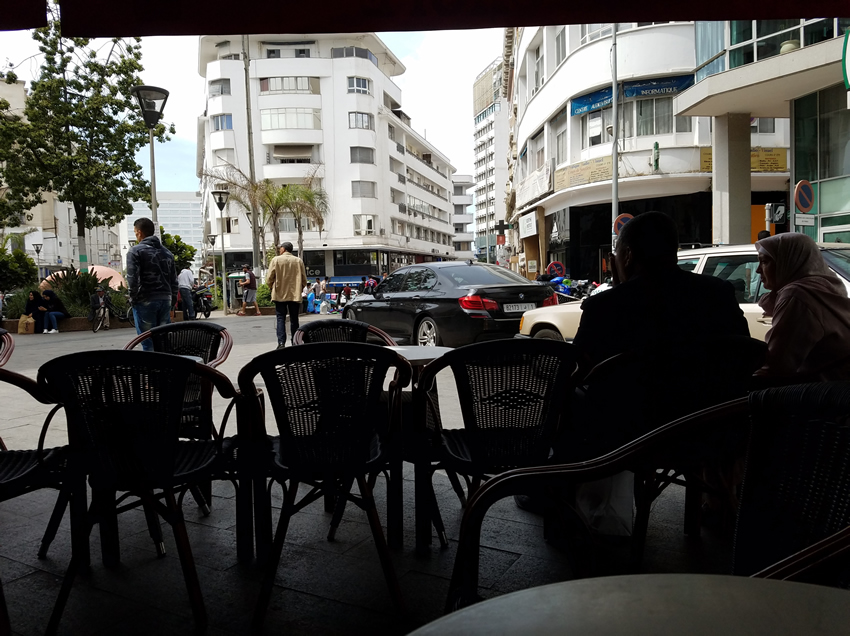
Above is one of the many coffee/snack places where we had a cup of coffee. This type of place is typical in all the Mediterranean Countries we visited.
During WW II, there was a British-American invasion of French North Africa. The Americans attacked at three different locations, one being Casablanca. It became an important strategic port during the War and hosted the Casablanca Conference in 1943, in which Churchill and Roosevelt discussed the progress of the war. Stalin did not attend because he did not want to leave the country during the siege of Stalingrad. Casablanca was the site of a large American air base, which was the staging area for all American aircraft for the European Theater of Operations during World War II. Morocco is a constitutional monarchy with an elected parliament. The King of Morocco holds vast executive and legislative powers, especially over the military, foreign policy and religious affairs.
I have to admit that after visiting Tangiers 21 years ago I was not expecting much in Casablanca, however I was wrong. We all think of the movie Casablanca when we think of this city, but that was 75 years ago, and apparently even then it was not the way we see it in the film.

We visited the Grand Mosque which is the only mosque in the country that allows non-Muslims to enter. The minaret here is square as it is in most mosques in Morocco, a style of the Moors. Square rather than round minarets is a style of the Moors
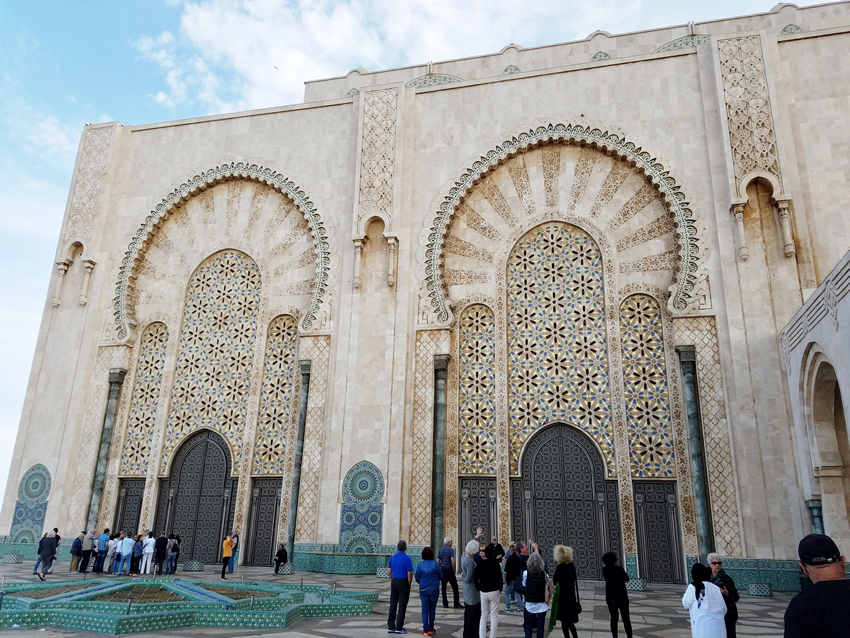
Outside of one wall of the Mosque.
It was built between 1987 and 1993 by the prior King, Hassam II. The Mosque is huge and can hold 20,000 worshippers inside as well as 100,000 outside. The architecture is Moorish which is a combination of Spanish and the Berbers. The designs in tiles, which are both inside and outside, are intricate and beautiful. We were required to remove our shoes before walking on the carpet, and although we were not required to wear scarves out of respect most of us did. One cannot help but realize that this is currently a money-making project as well as a religious place. But then, Christians are not immune to this either.
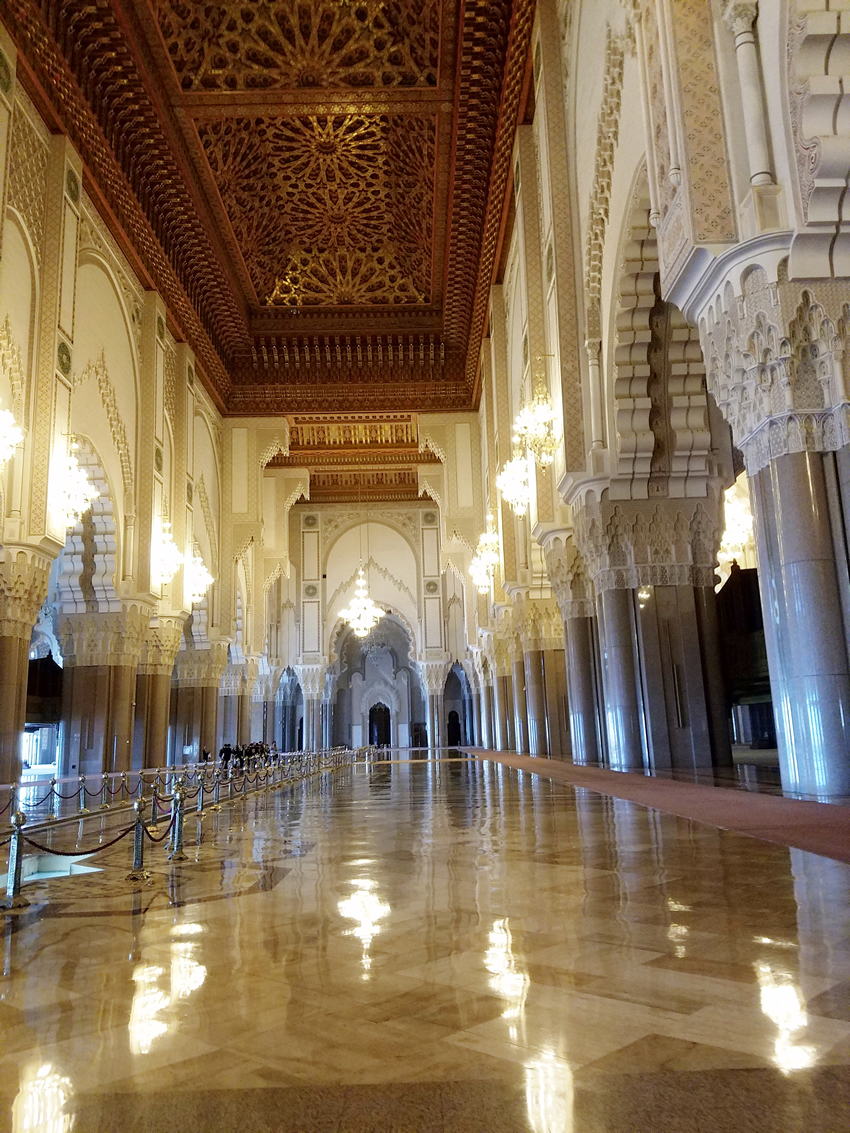
Above is the long hall that is off another part of the building. This is the long part of the T which the floor plan.
The artificial port in Casablanca has attracted investments, including many from the Chinese, and business opportunities. Casablanca today resembles most cities, but on a Sunday it was very calm with little car traffic and few if any horns blaring. Despite Friday being the holy day for Islam, the week-end here is Saturday and Sunday unlike Jordan where it is Friday and Saturday.
Morocco is firmly in the anti-terrorism camp and has imprisoned several terrorists, in February 2003, a Casablanca court sentenced three Saudi members of al-Qaeda to 10 years after they were accused of plotting to attack US and British warships in the Straits of Gibraltar and in recent years has arrested and sentenced many others.
We asked our guide about oil and he said that they were looking for it, but added that he hoped that they did not find it because all the countries that have it, have problems. Morocco's economy is considered a relatively liberal economy governed by the law of supply and demand. The services sector (read tourism) accounts for just over half of GDP. Industry, made up of mining, construction and manufacturing, is an additional quarter. The industries that recorded the highest growth are tourism, telecoms, information technology, and textiles. However, agriculture is also an important source of income. Salt is another export.
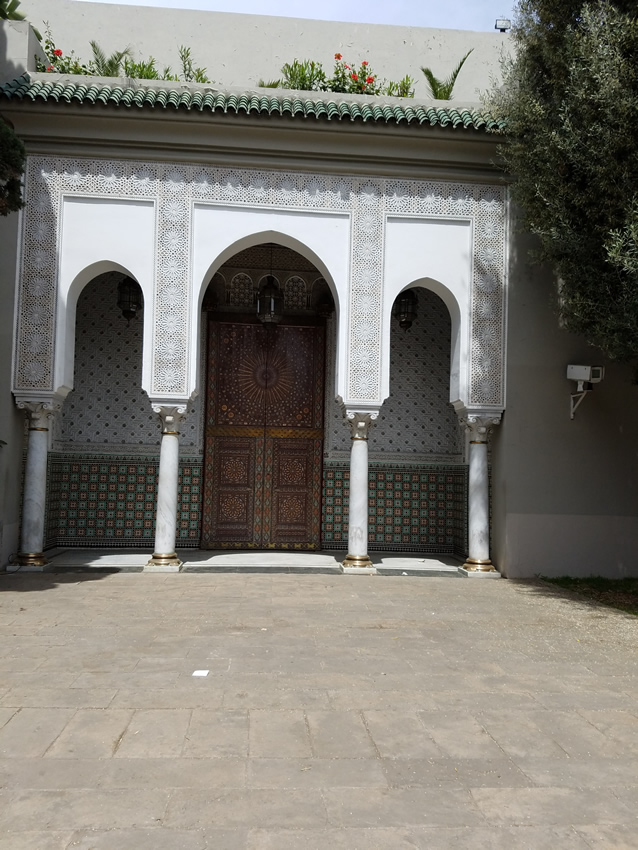
The exotic which one expects from Morocco is not present in Casablanca! The guide told us that when they want to see the exotic they go to Marrakesh which is a four hour drive south from Casablanca. Besides the Grand Mosque, Casablanca has a Grand Palace where the King lives when he is in town. Not as grand as one might expect, at least from the outside. From the outside the doors are the most interesting thing about this otherwise bland, square building.
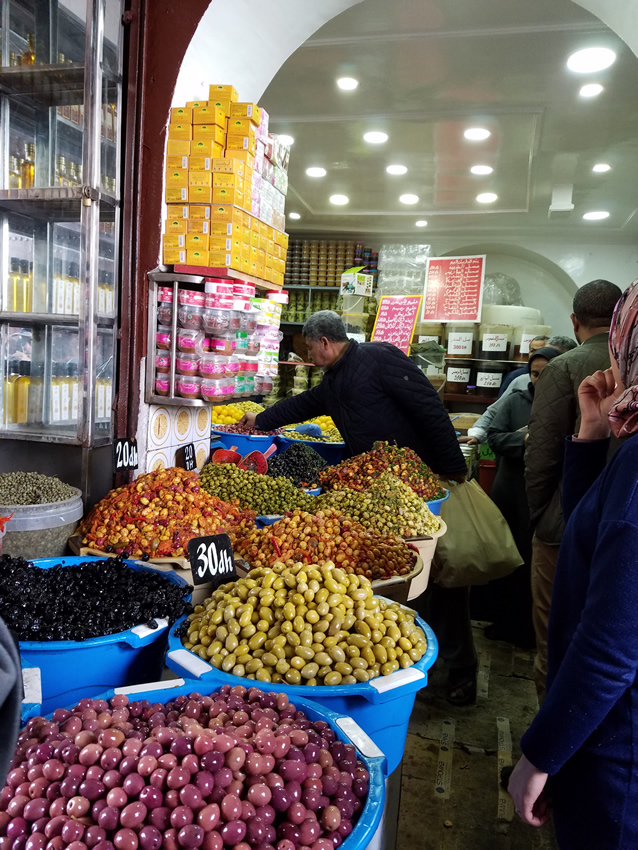
All types of olives are sold in an open market with the accompanying smells. I never realized the variety in types of olives. Besides green and black olives there were spicy ones, and many other varieties. There was also an open air market for vegetables (and they looked wonderful), fish and meat. According to the guide, Moroccan women like to shop for vegetables every other day, if not every day. What we have seen in Mediterranean countries (yes, I know, this port is on the Atlantic) is a preponderance of vegetables in diets. They fix them so deliciously!
The Notre Dame de Lourdes Church, was on our agenda. Easter Service, in French, was going on so we did not go inside very far. Which brings up the point that there are three official languages in Morocco: Arabic, French, and Berber. Until just recently, the Berbers (the original inhabitants of Morocco) had no written language, but feeling that their culture was being lost invented a new written alphabet. I do wonder about the sense of all these groups spending time learning a written language used in very few places, but this phenomenon is seen in many other places. Perhaps it is part of a search for identity, something that those of us who belong to what in Euro-America is the predominant culture, have difficulty understanding.

This is in the rocks just outside the Notre Dame de Lourdes Church.
Now one more port until we start across the Atlantic.
